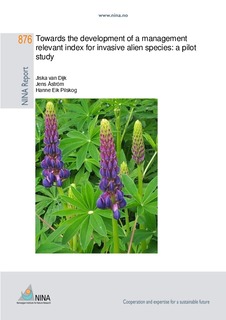| dc.description.abstract | Van Dijk, J., Åström, J., Pilskog, H. E. 2012. Towards the development of a management
relevant index for invasive alien species: a pilot study - NINA Report 876. 36 pp.
Alien species are a major threat to biodiversity and biological invasions are halted where possible, both at the international and at the national level and attempts are made to prevent new invasions. International agreements state that by 2020 invasive alien species and pathways are identified and prioritized, priority species are controlled or eradicated, and measures are in place to manage pathways to prevent their introduction and establishment. Already before 2010 attempts have been made to develop indicators of invasion to assess progress against the targets. In Norway, the Nature Index was developed as a framework for gathering and synthesizing scientific knowledge on the state of biodiversity in a particular ecosystem in a given area by using a set of indicators (e.g. species). In this pilot study we exploited the possibility to develop a similar framework on the state of invasive alien species in a particular ecosystem in a given area by developing the Invasive Alien Species (IAS) index. The test case used in this pilot study showed the feasibility of using the same framework as that of the Nature Index while adjusting the mathematical background applicable to IAS. Weighting and scaling of the indicators, here a subset of IAS representative for dominating and/or changing the natural biodiversity, were adjusted to reflect the impact of IAS on native bio-diversity. Weighting and scaling of each indicator is based on the principal of ecological effect (i.e. the weight or importance a species has in the index) combined with its invasion potential (i.e. scaling for its ecological risk on natural biodiversity when expanding and increasing in population distribution resp. size) based on the systematic risk assessment published by the Norwegian Biodiversity Information Centre. While the Nature Index ranges between 0 and 1, with 1 referring to intact ecosystems and 0 to degraded ecosystems, a higher IAS index actually refers to a potential higher risk to natural biodiversity. A lower IAS index shows that invasions are halted, for instance through eradication programmes. The proposed IAS Index is a framework for gathering and synthesizing the knowledge and monitoring data on the state of invasive alien species in a particular ecosystem in a given area. The proposed IAS Index allows for simple illustration on the state of invasive alien species. Both through graphical maps and easy readable figures changes in the state of invasive alien species can be presented. invasive species, nature index, invasive species management, index, fremmede arter, naturindeks, forvaltning av fremmede arter, indeks | nb_NO |
